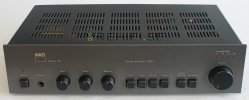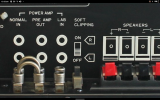DanielT
Major Contributor
Have you raised this? Tube amp as well as transistor-based can be class A or class AB based constructions. The single end, the black tube amp I showed is a class A design. All tube amp single end are class A based amplifiers.
Push – pull amplifiers use two nominally identical gain devices in tandem. One consequence of this is that all even-order harmonic products cancel, allowing only odd-order distortion. [11] This is because a push – pull amplifier has a symmetric (odd symmetry) transfer characteristic. Power amplifiers are of the push-pull type to avoid the inefficiency of Class A amplifiers. [Citation needed]
A single-ended amplifier will generally produce even as well as odd harmonics. [12] [13] [14] A particularly famous research on "tube sound" compared a selection of single-ended tube microphone preamplifiers to a selection of push-pull transistorized microphone preamplifiers. [15] The difference in harmonic patterns of these two topologies has henceforth been often incorrectly attributed as difference of tube and solid-state devices (or even the amplifier class). Push – pull tube amplifiers can be run in class A (rarely), AB, or B. Also, a class-B amplifier may have crossover distortion that will be typically high order and thus sonically very undesirable indeed. [16]
Class-A amplifiers measure best at low power. Class-AB and B amplifiers measure best just below max rated power.[citation needed]
Soft clipping is a very important aspect of tube sound especially for guitar amplifiers. A hi-fi amplifier should not normally ever be driven into clipping. The harmonics added to the signal are of lower energy with soft clipping than hard clipping. However, soft clipping is not exclusive to tubes. It can be simulated in transistor circuits (below the point that real hard clipping would occur). (See "Intentional Distortion" section.)
Large amounts of global negative feedback are not available in tube circuits, due to phase shift in the output transformer, and lack of sufficient gain without large numbers of tubes. With lower feedback, distortion is higher and predominantly of low order. The onset of clipping is also gradual. Large amounts of feedback, allowed by transformerless circuits with many active devices, leads to numerically lower distortion but with more high harmonics, and harder transition to clipping. As input increases, the feedback uses the extra gain to ensure that the output follows it accurately until the amplifier has no more gain to give and the output saturates.

 en.wikipedia.org
en.wikipedia.org
Took some screenshots, mostly to show that it can be found online (plus a little from Wikipedia).Please do not ask me to explain what Douglas Self
show. Too advanced for me but in any case for those who are interested.
Edit:
As for the tube amp. At the aforementioned Vintage DIY fair, I happened to hear two tube amp DIY people talk about the plans for their coming project. One of them asked (the first thing he asked): Found some sensible, good so far?
What he asked you can think about. Those of you who work with tubis know exactly what it's about.
Push – pull amplifiers use two nominally identical gain devices in tandem. One consequence of this is that all even-order harmonic products cancel, allowing only odd-order distortion. [11] This is because a push – pull amplifier has a symmetric (odd symmetry) transfer characteristic. Power amplifiers are of the push-pull type to avoid the inefficiency of Class A amplifiers. [Citation needed]
A single-ended amplifier will generally produce even as well as odd harmonics. [12] [13] [14] A particularly famous research on "tube sound" compared a selection of single-ended tube microphone preamplifiers to a selection of push-pull transistorized microphone preamplifiers. [15] The difference in harmonic patterns of these two topologies has henceforth been often incorrectly attributed as difference of tube and solid-state devices (or even the amplifier class). Push – pull tube amplifiers can be run in class A (rarely), AB, or B. Also, a class-B amplifier may have crossover distortion that will be typically high order and thus sonically very undesirable indeed. [16]
Class-A amplifiers measure best at low power. Class-AB and B amplifiers measure best just below max rated power.[citation needed]
Soft clipping is a very important aspect of tube sound especially for guitar amplifiers. A hi-fi amplifier should not normally ever be driven into clipping. The harmonics added to the signal are of lower energy with soft clipping than hard clipping. However, soft clipping is not exclusive to tubes. It can be simulated in transistor circuits (below the point that real hard clipping would occur). (See "Intentional Distortion" section.)
Large amounts of global negative feedback are not available in tube circuits, due to phase shift in the output transformer, and lack of sufficient gain without large numbers of tubes. With lower feedback, distortion is higher and predominantly of low order. The onset of clipping is also gradual. Large amounts of feedback, allowed by transformerless circuits with many active devices, leads to numerically lower distortion but with more high harmonics, and harder transition to clipping. As input increases, the feedback uses the extra gain to ensure that the output follows it accurately until the amplifier has no more gain to give and the output saturates.

Tube sound - Wikipedia
Took some screenshots, mostly to show that it can be found online (plus a little from Wikipedia).Please do not ask me to explain what Douglas Self
show. Too advanced for me but in any case for those who are interested.
Edit:
As for the tube amp. At the aforementioned Vintage DIY fair, I happened to hear two tube amp DIY people talk about the plans for their coming project. One of them asked (the first thing he asked): Found some sensible, good so far?
What he asked you can think about. Those of you who work with tubis know exactly what it's about.
Attachments
-
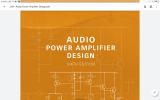 shot_2022-01-18_06-49-46.png913.8 KB · Views: 94
shot_2022-01-18_06-49-46.png913.8 KB · Views: 94 -
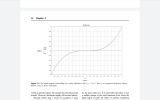 shot_2022-01-18_06-52-33.png370.1 KB · Views: 83
shot_2022-01-18_06-52-33.png370.1 KB · Views: 83 -
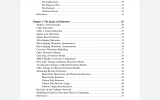 shot_2022-01-18_06-55-02.png541.4 KB · Views: 70
shot_2022-01-18_06-55-02.png541.4 KB · Views: 70 -
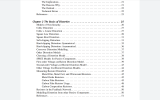 shot_2022-01-18_06-55-04.png541.4 KB · Views: 66
shot_2022-01-18_06-55-04.png541.4 KB · Views: 66 -
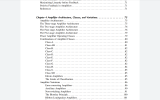 shot_2022-01-18_06-55-18.png459.9 KB · Views: 78
shot_2022-01-18_06-55-18.png459.9 KB · Views: 78 -
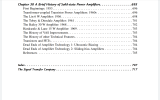 shot_2022-01-18_07-17-46.png279.3 KB · Views: 68
shot_2022-01-18_07-17-46.png279.3 KB · Views: 68 -
 shot_2022-01-18_07-46-44.png422.9 KB · Views: 67
shot_2022-01-18_07-46-44.png422.9 KB · Views: 67 -
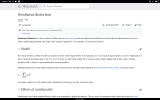 shot_2022-01-18_07-43-24.png210.3 KB · Views: 83
shot_2022-01-18_07-43-24.png210.3 KB · Views: 83 -
 shot_2022-01-18_07-46-15.png344.6 KB · Views: 89
shot_2022-01-18_07-46-15.png344.6 KB · Views: 89
Last edited:



